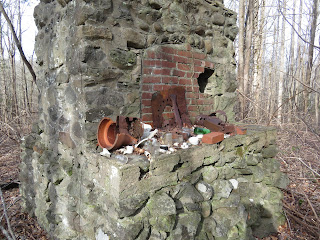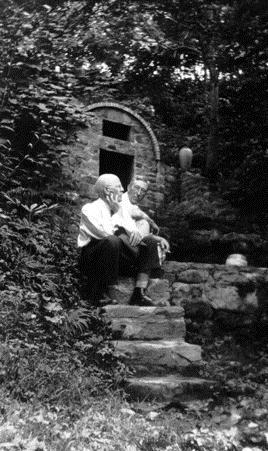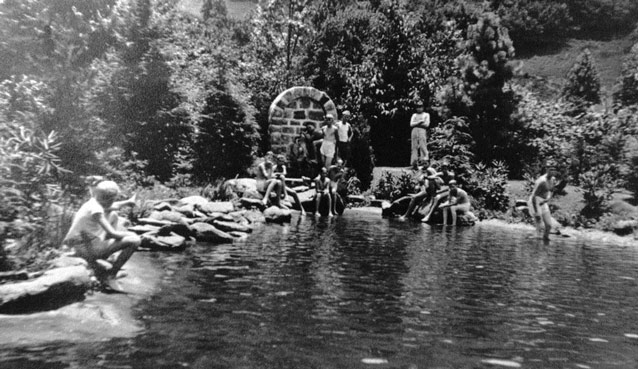The Uwharrie Trailblazers convened for our annual meeting in the community of Ophir. We began with a short commentary by hike leader, Jim Rich. The topic and subject of today's hike is the Russell Mine. Located just a few miles away, the Russell Mine operated from 1882 until about 1920. It produced about 16,000 ounces of gold. After the short introduction, our group car pooled for the short drive to Big Creek.
During the summer, there may not be any water in Big Creek but today there was a rock hop of mild proportions. A few wet feet but no casualties. Once on the opposite side, the "Big Cut" is right in front of you. Most of the ore processed at Russell Mine came from the Big Cut. The pit measures 300' x 150' and is 60' deep. Several shafts extend downward. I'm told they are as much as 200' deep.
What remains of the mine today, just these rock walls. The photo below is from the operational days of the mine. Ore extracted from the Big Cut arrives via conveyor behind the building in the photo. Stampers in the building, crush the ore so it can be processed, separating gold.
Russell Mine in the day
Spectrum 14 News joins in the fun
With such a large operation, many people were drawn to this area. Reports are that 40 people worked in shifts 24 hrs a day at the mine in its heyday. There was a general store, hotel and many homes in the vicinity.
Big Creek flows into the Uwharrie less than a half mile from the Russell Mine. Just downriver from the confluence is a low "u" shaped rock wall across the river. When I first encountered this on a paddle trip, I was convinced it was a Native American fish weir. However, I have since been told it was a dam, impounding water up Big Creek, for use at the Russell Mine.
Our group poses by the Russell Mine foundation. There appear to be about 35 of us here. That is less than the mine employed at one time.
On the opposite side of Big Creek from the Big Cut, there is a ridge with this shaft and other pits. Russell Mine extracted ore from here as well.
Back in Ophir, I spot this Redheaded Woodpecker busy extracting insects from this White Oak.
Ophir gets its name from a Biblical reference. King Solomon received gold and other commodities from Ophir. Gold from Ophir has other biblical references but its location is subject of speculation. The folks from this North Carolina community borrowed the name from the Bible since their community had such a strong gold connection. In 1832 gold was discovered nearby. A mine named "Steel Mine" operated on their side of the Uwharrie River, opposite that of the Russell Mine but very close as the Raven soars. It operated sporadically from 1832 to the 1880s.

Note the push button controls on this ancient stove. Heating huge pots of chili on small burners is a challenge, even for Jedi culinary artists.
The lunch spread was outstanding. The club provided chili and members brought covered dishes
How many Scoville units in that hot sauce?
Dr Gary Freeze of Catabwa College, lectures on the human history of the Uwharrie region. Using a North Carolina road map, Gary shows us how the colonial and modern day transportation routes create, almost a circle around the Uwharries. Population centers arc across North Carolina but avoid the Uwharries, and always have. The geology and topography make that so. To me, the most telling statistic was the percentage of land in agriculture in the late 1800's
Guilford County - 62%
Caburrus County - 89%
Randolph County - 38%
Stanley County - 28%
Montgomery County - 14%
We just don't have good soil. Even on my tract of land, I can see that this is true. Along our road, there is good arable land but just away from the road, it turns. There are many patches of quartz, a subtle ridge of ryolite and rocky soil that only Chestnut Oaks can make a living on.
Gary spoke about the land and how it ran out of nutrients decades ago. That prompted the federal government to buy out the landowners during the Depression and those land purchases eventually led to the Uwharrie National Forest. As the population centers around us fill in, our future may be analogous to being the central park of a Manhattan.

Next up, Mary Joan Pugh reviews our trail strategy. In conjunction with the Uwharrie National Forest, our group has worked to develop what we think is in the best interest of the hiking public. Topping our list is closing the gap in the southern Birkhead Wilderness. One parcel of property separates trail from the Birkhead Wilderness to Uwharrie National Recreation Trail, at High Pine Church Road. Also seen as a priority, making Camp 3 Trail official. It is an integral part of the Birkhead trail network but not recognized by the Forest Service. The SAWS crew which was contracted to clear Birkhead trails last September, was not able to work on the Camp 3 trail. As a result, we have 6-7 blowdown areas where "walk around trails" exist instead of clear trail. Another priority is creating a loop or trail system in the Walker Creek and King Mountain area with a new trailhead. Finally, we'd like to see a trail connecting Thornburg and Tot Hill, roughly following Betty McGee Creek. These last two items, we feel, are necessary to alleviate some of the pressure the Birkhead trails are experiencing.
District Ranger, Mike Spisak, gave us an explanation on how the FS acquires property. Since our group has been involved with or supported several acquisitions destined to become National Forest, it is interesting to know the process. We not only compete with other NC areas for funding, but ultimately compete nationally. North Carolina has been quite successful in these funding battles. Understanding why properties sit and wait to be acquired is often difficult to comprehend. However, once they are public lands in perpetuity, makes it all worthwhile. As they say, forever is a long time.
We recognized the trail building and maintain efforts of Stanley Siceloff, Steve Chase, Merritt Maness and Marcus West from our trail crews. I'd like to thank all the volunteers for their efforts.
Joe White spoke about a new initiative, our trail adoption program. We are close to rolling this out and will be hashing out details this coming week.
David Craft mentioned some changes on our steering committee. Karen Auman has had to step down. Karen always stepped up when something needed to be done. She coordinated the bus transportation for the thru hike, coordinated the annual meeting venue and food preparation, contributed to the trail crew, supported the thru hike in so many ways, even served as auctioneer at the Trail Celebration Days. We'll miss her but I suspect she'll be on the periphery ready to help again. David mentioned two additions to the committee, Kim Anderson and Abi Winegarden. We look forward to them being part of our forest family.
Finally, in attendance was Mike Beck, one of our wonderful Forest Service friends whom we have worked closely with. Mike is leaving for a FS job in Michigan where he is from and still has family. We will miss Mike tremendously.



















































